The debate surrounding year-round schooling is a multifaceted issue that has garnered increasing attention in the world of education. At its core, year-round schooling proposes a significant shift from the traditional academic calendar, intending to enhance learning experiences and academic outcomes. This article delves deep into the concept of year-round schooling, exploring its structure, functionality, and the various forms it takes.
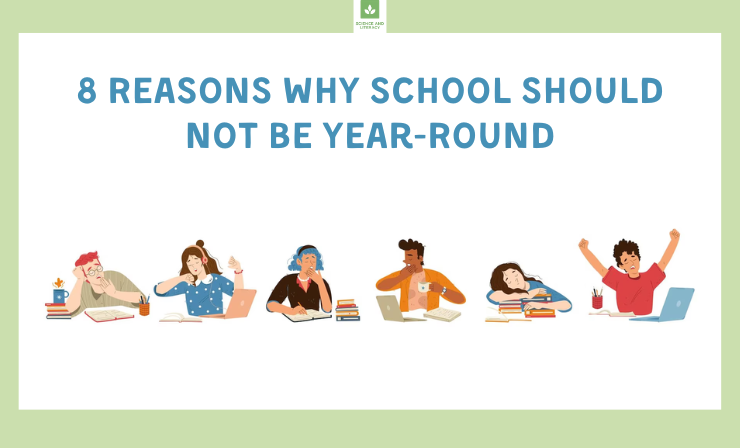
Year-round schooling, often perceived as a solution to the perennial issue of summer learning loss, reimagines the school year with shorter, more frequent breaks, as opposed to the conventional long summer vacation. This model is rooted in the belief that consistent engagement in educational activities can lead to better retention of knowledge and overall academic performance. However, this system is not without its critics, and a closer examination of its implications is crucial for a comprehensive understanding.
There should be an option (summer classes), but kids from broken homes should not be the reason why the state should school ALL kids all year round. It can kill creativity, & reduces bonding time w parents in favour of strangers. Some schools r great, in some areas they’re tragic
— Blonde, you know what you are? (@BlondeAre) July 22, 2022
We will explore the drawbacks of year-round schooling, carefully balancing them against its benefits. These drawbacks range from potential impacts on family life and student mental health to logistical challenges faced by schools and districts. Furthermore, the article seeks to capture the voices of those at the heart of this issue – the students. Understanding their perspectives on year-round schooling is vital, as their experiences and opinions are central to the discussion.
By dissecting these various elements, this article aims to provide a thorough overview of the year-round schooling system. The goal is to equip parents, educators, and policymakers with a well-rounded understanding, enabling informed decisions that prioritize the needs and well-being of students in an ever-evolving educational landscape.
What you’ll find on this page:
- The Concept of Year-Round Schooling →
- How Does the Year-Round Schooling System Work? →
- What Kinds of Year-Round Schools Exist? →
- 8 Reasons Why School Should Not Be Year-Round →
- Benefits of Year-Round School →
- What Teens Think About Year-Round School →
The Concept of Year-Round Schooling
Many people assume that schools in the U.S. generally follow a nine-month academic year, but this is not always the case. While the majority do, a small portion, about 3,200 out of approximately 133,000 K–12 schools, operate on a year-round schedule. This doesn’t necessarily mean more school days; often, it’s the same number spread throughout the year instead of having a long summer break.
If you’ve ever wondered what it truly means to attend school throughout the entire year, this video offers an insightful exploration of this distinctive educational approach.
Year-round schooling involves distributing the teaching days evenly over the entire year. This approach can vary; some schools extend their academic year, while others spread the standard number of days over a longer period. The term “year-round” doesn’t imply continuous schooling all year or more school days than traditional schedules. It simply reorganizes the calendar to shorten the summer vacation.
The push for year-round schooling gained momentum due to concerns about students lagging in their studies, especially after the challenges posed by remote learning during the pandemic. Adrian Bustillos from the Aldine Independent School District in Texas highlighted the significant summer learning loss observed in recent years. Research indicated that students were falling behind by two to three years in subjects like math and reading.
To combat this, Harris Elementary School in the Aldine District switched to a modified calendar. Since 2018, the adoption of year-round schooling has grown from 2.5% to 4% in 2020, impacting over 3 million students across the country. Aldine ISD, spurred by state incentives, has extended the school year by 30 days at four of its schools, joining this emerging trend.
How Does the Year-Round Schooling System Work?
The year-round schooling system restructures the traditional academic calendar by breaking up the year into several shorter breaks instead of one extended summer vacation. Typically, these breaks might last two to three weeks, creating a more balanced schedule that allows for various unique activities. The structure of these breaks can vary: some schools might have four academic quarters of 45 days each, separated by 15-day breaks, while others could have three 60-day terms with 20-day intermissions, or even two 90-day halves with 30-day pauses in between.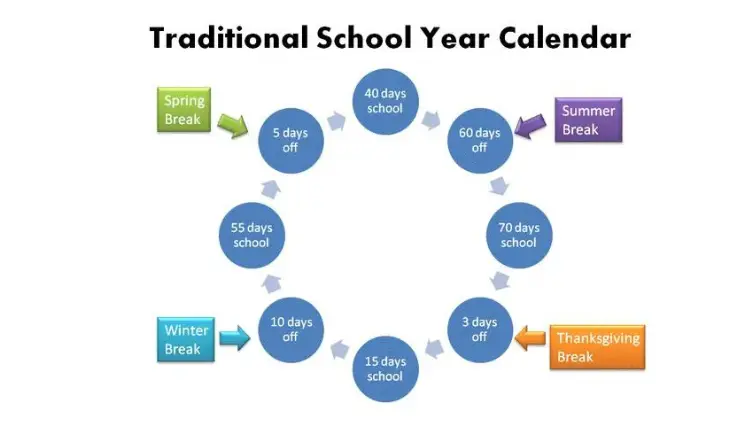
This system not only changes the rhythm of the school year but also offers students more flexibility in managing their assignments, as they have regular intervals to complete their work. If students struggle with their coursework, online assignment help is a viable option to consider.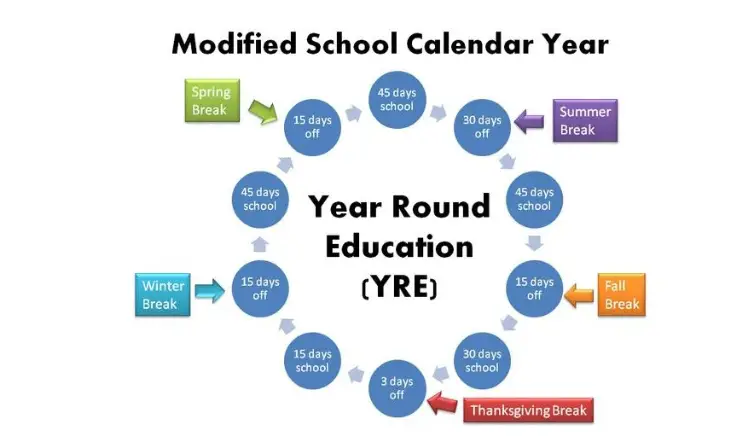
Additionally, some year-round schools include an “intersession,” an extra week or two for students to take additional courses outside their normal curriculum. This, however, extends the overall length of the school year. On average, year-round schools are open for about 189 days annually, which is nine days longer than the standard 180-day calendar.
In terms of organization, there are single-track schools where all students follow the same yearly schedule. In contrast, multitracking is used in some schools, especially to reduce overcrowding. In multitracking, different groups of students follow distinct academic calendars within the same institution.
What Kinds of Year-Round Schools Exist?
Year-round schools typically come in two formats: single-track and multi-track calendars. Both types rearrange the standard 180 school days to include several shorter breaks throughout the year, rather than a long summer vacation.
1. Single-Track Calendar
In the single-track, or balanced calendar, all students adhere to the same schedule. This approach often incorporates intersessions, which are periods for extra learning, offering an alternative to the conventional summer school model. The single-track calendar’s primary goal is to distribute breaks evenly throughout the year, maintaining a consistent academic rhythm.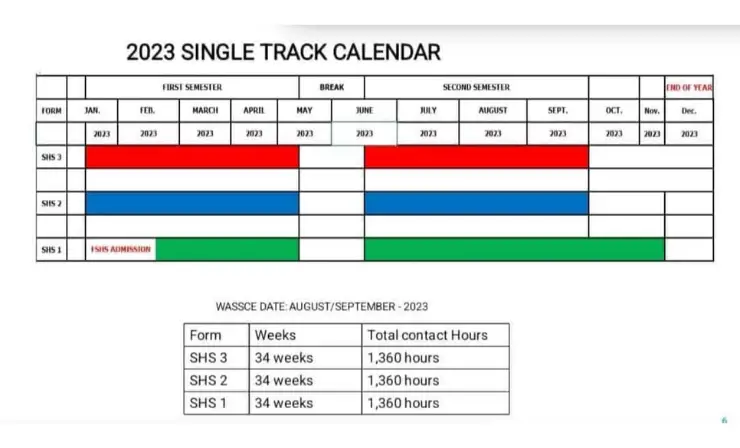
2. Multi-Track Calendar
The multi-track calendar, on the other hand, is usually adopted to address overcrowding in schools. It staggers schedules so that while some students are in school, others are on break. This system doesn’t necessarily extend the overall school year; instead, it shortens the summer break and introduces or extends breaks in other seasons.
Despite its name, the multi-track calendar doesn’t increase the total instructional days. Most of these calendars still operate for 36 weeks (180 days), similar to traditional schedules. An exception was the Concept 6 calendar, which only had 32 weeks of instruction.

Traditional Schools vs. Year-Round Schools
To learn more and get ready for upcoming discussions, watch the video “Traditional Schools vs. Year-Round Schools.”
There was an initial belief that multi-track and other year-round calendars could enhance student achievement by reducing summer learning loss. The theory suggested that shorter, more frequent breaks would lead to better retention of knowledge. However, this hasn’t been consistently supported by evidence. Studies have shown that any educational gains made by attending school during the summer are offset by slower learning during breaks in other seasons.
Consequently, across all seasons, the amount of teaching and learning in multi-track systems is similar to that of traditional calendars. For example, from 1998 to 2011, California schools that switched to multi-track calendars did not show improved performance; in fact, they scored slightly lower than those on traditional schedules.
8 Reasons Why School Should Not Be Year-Round
While the benefits of year-round schooling are often highlighted, they may not be sufficient to outweigh its drawbacks. Firstly, the continuous academic calendar, though aiming to enhance learning, often disrupts the crucial balance between education and rest, potentially leading to student and teacher burnout. Additionally, the restructured schedule can significantly interfere with traditional family dynamics, complicating long-standing vacation plans and childcare arrangements.
Financial implications also emerge as a major concern, with both schools and families facing increased costs due to the extended operational demands of the year-round system. Furthermore, the alteration of the traditional summer break limits students’ opportunities for essential developmental experiences like summer jobs, internships, and leisure activities, which play a key role in holistic growth. With these significant issues in mind, let’s delve deeper into the reasons why year-round schooling might not be the optimal choice.
1. Difficulty in Retaining Information

Year-round schooling, characterized by its shorter breaks, may impede students’ ability to retain information effectively. Research has shown that students benefit from longer breaks, which provide ample time for the consolidation and processing of learned material. This is crucial for converting short-term memory into long-term understanding.
In a year-round schooling setup, the lack of extended breaks can lead to a repetitive cycle of learning new content and forgetting previously learned material due to insufficient processing time. Educational expert Dr. John Hattie’s research supports this, highlighting the importance of downtime in the learning process for deeper comprehension and retention. This constant cycle of superficial learning can ultimately hinder academic performance, as students might not develop a strong foundation in their knowledge base.
I recommend watching this insightful video featuring Professor John Hattie, currently serving as Professor of Education and Director of the Melbourne Education Research Institute at the University of Melbourne, Australia, since March 2011, and formerly a Professor of Education at the University of Auckland. His extensive research covers areas such as educational performance indicators, evaluation, creativity measurement, and various teaching and learning models, making this video a valuable resource for anyone interested in educational research.
Why It’s Important: The capacity to retain and process information effectively is a cornerstone of academic success. A schooling structure that potentially undermines this critical aspect of learning deserves thorough examination and consideration. The implications of compromised information retention are far-reaching, potentially affecting students’ academic trajectories and their preparedness for higher education and professional endeavors.
2. Risk of Student Burnout and Impact on Mental Health

Year-round schooling’s continuous academic schedule can significantly contribute to student burnout, negatively impacting mental health. Studies indicate that students in year-round settings experience higher stress and anxiety levels. The lack of substantial breaks for relaxation in such a system can lead to mental exhaustion, diminishing students’ capacity to manage stress and anxiety effectively.
Without adequate downtime, students are deprived of the opportunity to mentally recover from academic pressures, potentially leading to burnout. Psychologist Dr. Michael Thompson has noted the importance of breaks for psychological well-being in school-aged children. This unrelenting academic pressure can intensify mental health issues like anxiety and depression, adversely affecting students’ overall well-being and academic performance.
I highly recommend watching this insightful video featuring Michael Thompson discussing the significant pressure that schools place on children and the impact this has on their well-being and development.
Why It’s Important: The mental health of students is as critical as their academic achievements. The risk of burnout and the negative impact on mental health present significant challenges in the year-round schooling model. Prioritizing students’ mental wellness is essential, not only for their academic success but also for their long-term health and development. Ignoring these aspects could result in detrimental outcomes that extend beyond the classroom and into students’ future lives.
3. Increased Costs for Schools and Families

The transition to year-round schooling often entails additional expenses for both educational institutions and families. According to the National Education Association, schools could face up to 20% more in operational costs. This increase is due to the need for more staffing, modifications in scheduling, and higher demands for resources such as transportation and ongoing maintenance. For instance, a case study in California revealed that year-round schools required additional administrative staff and utility expenses to accommodate the year-long operation.
Families are also affected financially. With shorter and more frequent breaks, parents may need to arrange for more childcare, leading to increased expenses. Additionally, travel costs may rise as families try to plan vacations during off-peak times, which are often shorter and more crowded. A survey conducted by a parent-teacher association found that many families struggle with these additional childcare costs, making year-round schooling a less attractive option.
Watch CBS New York’s John Dias as he provides an insightful analysis of the latest figures in this engaging video.
Why It’s Important: The economic implications of year-round schooling are a critical factor to consider. These increased costs could make this educational model less viable for schools with limited budgets and for families who already face financial constraints. This situation could exacerbate educational disparities, hindering efforts to achieve greater equality in schooling access and quality.
Explore the compelling article “Why Students Should Not Wear Uniforms: A Thoughtful Exploration with 9 Reasons, Studies, and Statistics” to gain an in-depth perspective on the school uniform debate. Offering a detailed analysis supported by research and statistics, this piece thoroughly examines the reasons and consequences of adopting a no-uniform policy in educational institutions.
4. Disruption to Family Time and Challenges in Childcare and Family Scheduling

Year-round schooling significantly disrupts established family routines and complicates childcare and family scheduling. The frequent, shorter breaks that define this schooling model contrast sharply with the traditional long summer vacation, making it challenging for families to plan extended holidays and coordinate schedules. A study from a family counseling center highlights how these disrupted routines can impact family dynamics and children’s sense of stability.
Working parents, in particular, face added pressures in arranging consistent childcare during these intermittent breaks. This not only impacts the parents’ work-life balance but also adds to the family’s overall stress. For example, a survey of working parents showed that many had to make complex arrangements for childcare during shorter breaks, often at a higher cost and inconvenience.
I recommend watching “The Importance of Family Time: Luca at TEDxYouth,” a thought-provoking video that delves into the significance of spending time with family and its impact, as presented by Luca in a TEDxYouth talk.
Why It’s Important: The challenges posed by year-round schooling to family time and childcare are not just logistical but also emotional. Quality family time and stable childcare arrangements are essential for the healthy emotional and social development of children. Disruptions in these areas due to year-round schooling schedules can have significant ramifications on family well-being and children’s overall growth, making it a substantial drawback of this educational system.
5. Limitations on Summer Jobs and Internships

The structure of year-round schooling can significantly curtail students’ access to summer jobs and internships, which are traditionally aligned with the long summer break. According to the National Center for Education Statistics, the participation rate in these activities is notably lower for students in year-round schools. This discrepancy is primarily because the shortened breaks provided in year-round schooling overlap with the typical summer job and internship season. A survey conducted by a youth employment agency revealed that students in year-round schools often miss out on job opportunities that are not only a source of income but also crucial for gaining real-world experience.
This limitation can have far-reaching effects on students’ work experience, financial independence, and practical learning opportunities outside the academic environment. For example, internships in certain industries are predominantly available during the summer, and students in year-round schools may find themselves unable to take advantage of these opportunities.
Don’t miss this informative video which offers valuable insights into how summer internships can significantly benefit high school students’ learning and career development.
Why It’s Important: Summer jobs and internships play a critical role in preparing students for their future careers and in developing key life skills. They offer practical experiences that are invaluable in the job market and for personal growth. Therefore, the restriction imposed by year-round schooling on these opportunities is a significant concern, as it could adversely affect students’ readiness for the workforce and limit their skill development.
6. Teacher Burnout and Administrative Challenges

Year-round schooling can significantly increase the risk of teacher burnout and pose substantial administrative challenges. Research by the National Education Association has highlighted a higher incidence of burnout and job dissatisfaction among teachers working in year-round educational settings. The constant operation of schools throughout the year leaves teachers with limited opportunities to rest, recover, and engage in professional development, essential for their rejuvenation and effective teaching. Anecdotal evidence from teachers in year-round schools points to the heightened stress and reduced job satisfaction due to the lack of substantial breaks.
Administratively, the year-round model demands the coordination of complex schedules and continuous maintenance of school facilities, which can be both labor-intensive and financially burdensome. School administrators often find themselves grappling with logistical complexities and resource allocation challenges unique to this system.
I highly recommend watching the video “The Burnout Equation: America’s Teacher Shortage Crisis” for an in-depth understanding of the current challenges faced by educators in the U.S. and the growing crisis of teacher shortages due to burnout.
Why It’s Important: Teacher well-being is paramount to the quality of education provided, and their burnout can negatively impact student learning and overall school morale. Furthermore, the efficiency of school administration is crucial for the smooth functioning of any educational model. The increased strain placed on teachers and administrators in year-round schooling systems represents a significant drawback, potentially compromising the effectiveness of education and the health of the educational environment.
7. Logistical Complications, Extracurricular Disruptions, and Complexity in Scheduling and Resource Allocation

The shift to year-round schooling brings with it a host of logistical challenges, particularly in managing varied schedules and integrating extracurricular activities within this framework. This complexity often results in operational difficulties for schools, as evidenced by a study from the School Administrators Association, which found that year-round schools frequently struggle to synchronize their academic calendar with extracurricular and interscholastic sports schedules. This misalignment can lead to students missing out on crucial activities that contribute to their overall development.
Furthermore, efficient resource management becomes a pressing issue as schools must continuously navigate staffing, facility usage, and budget allocations without the traditional downtime of summer. This ongoing operation often demands more dynamic resource management strategies, as highlighted in a report by the Educational Resources Planning Institute, which points to the increased burden on administrative staff to ensure seamless school functioning.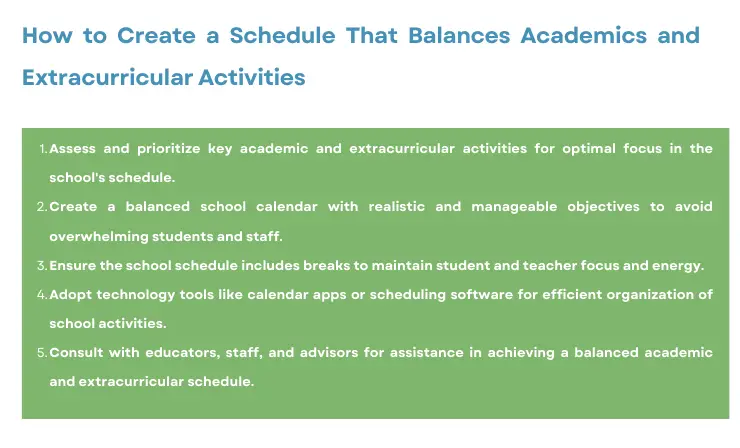
Why It’s Important: The ability of schools to operate smoothly and offer a diverse range of extracurricular activities is fundamental to providing a comprehensive educational experience. The additional logistical and scheduling complexities that come with year-round schooling can significantly impede these aspects, potentially detracting from the quality of education and the enrichment of students’ school life. These operational challenges represent considerable drawbacks, underscoring the need for careful planning and resource allocation in year-round educational settings.
8. Restrictions on Traditional Summer Activities

Year-round schooling substantially restricts students’ participation in traditional summer activities, a key component of their social and personal development. The condensed summer breaks inherent in year-round calendars mean students are in school during periods typically reserved for summer camps, sports, and other enriching activities. A survey conducted by the American Camp Association revealed a decrease in enrollment from students attending year-round schools, suggesting a direct impact on their ability to participate in such programs.
These limitations not only restrict students from engaging in recreational and developmental pursuits but also curtail their opportunities for social interaction and exploration of interests outside the academic sphere. This restriction is particularly evident during what is traditionally a more relaxed and explorative period for students. The impact is seen in a study by the Youth Development Institute, which shows that students in year-round schooling miss crucial opportunities for unstructured play and exploration, which are essential for holistic growth.
I recommend watching this informative video showcasing the diverse range of day and summer camps offered by the YMCA of Greater Cleveland, perfect for exploring various fun and engaging activities for children.
Why It’s Important: Engagement in summer activities is crucial for the all-round development of students. These activities provide diverse learning experiences, aiding in the development of social skills and personal interests, which are not typically addressed within the confines of a classroom. The reduction of these opportunities in year-round schooling can have significant implications on the overall growth, well-being, and future prospects of students, highlighting a major drawback of this educational model.
Overall, while year-round schooling offers certain advantages like reduced learning loss and continuous academic engagement, it also presents several significant drawbacks. These include challenges in retaining information, increased risk of student and teacher burnout, financial burdens, disruptions to family life and extracurricular activities, limitations on traditional summer experiences, and complexities in school management.
These factors collectively suggest that the potential negatives of year-round schooling may outweigh its benefits, making it essential for educators, parents, and policymakers to carefully weigh these considerations when deciding on the best educational model for their communities.
Benefits of Year-Round School
Although the concept of year-round schooling is met with various objections, it is not without its merits. Let’s delve into the potential benefits that this educational structure may offer.
Check out this intriguing video where Special Correspondent Alison Steward takes us inside a West Virginia school that has successfully adopted a year-round calendar. This insightful exploration reveals how spreading the same number of teaching days throughout the year, as done by this school, impacts student achievement. Administrators, teachers, and parents share their experiences, making it a must-watch for anyone interested in how altering the school calendar can influence educational outcomes.
1. Reduced Learning Loss vs. Disrupted Family Routines
Traditional summer vacations often lead to a regression in students’ academic skills, particularly in critical areas like math and reading. Year-round schooling, with its shorter, more frequent breaks, helps maintain academic continuity, reducing this ‘summer slide.’ This consistent educational engagement prevents the substantial knowledge loss typically observed after long periods of academic inactivity, helping students stay on track with their learning goals.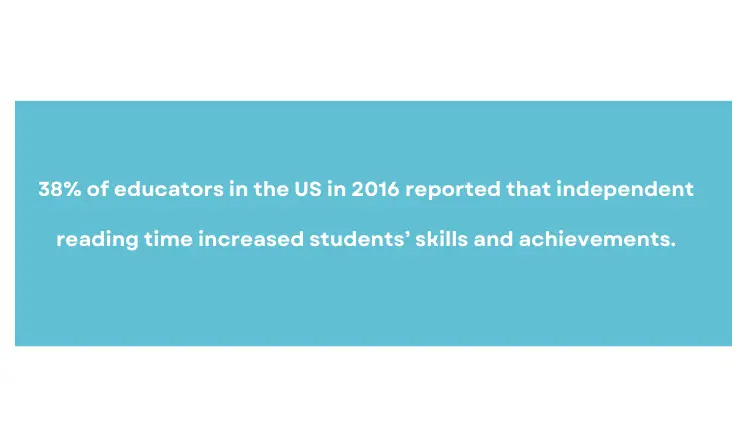
While year-round schooling can reduce learning loss by avoiding long summer breaks, it may disrupt traditional family routines. Families accustomed to long summer vacations for bonding and relaxation might find the frequent breaks throughout the year challenging to adapt to, potentially affecting family dynamics and time for extended family gatherings.
2. Consistent Engagement vs. Overburdening Students
Year-round schooling keeps students in a continual learning mode. This consistent engagement helps in maintaining a steady academic rhythm, preventing the disruption often caused by the long summer break. It ensures students remain in the habit of studying, attending classes, and engaging with educational material, which can lead to better academic performance and a more stable learning environment.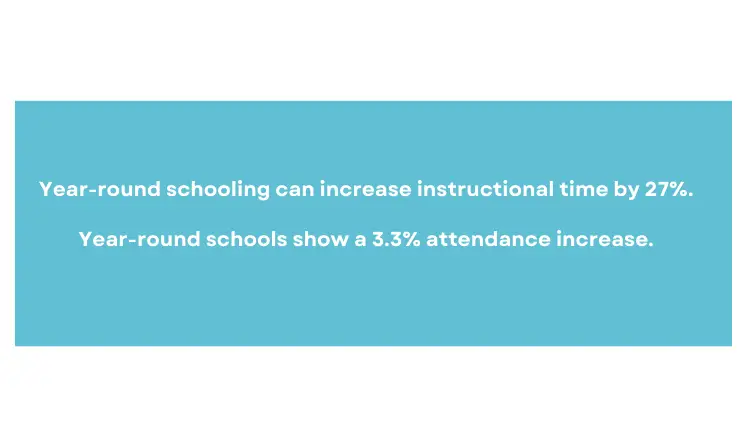
Although consistent engagement in year-round schooling prevents the disruption of long summer breaks, it could also lead to student fatigue. Continuous academic pressure without a substantial break might overburden students, potentially leading to burnout and a decrease in overall enthusiasm for learning.
Discover enlightening perspectives in “7 Research-Based Reasons Why Students Should Not Have Homework: Academic Insights, Opposing Perspectives & Alternatives“. This engaging article delves into the effects of homework on students, presenting well-researched arguments and examining various alternative approaches to foster effective learning.
3. Better Use of Resources vs. Increased Operational Costs
This system allows for a more efficient use of school facilities and resources. In multi-track systems, it can help manage overcrowding by having only a portion of the student body on campus at any given time. This not only maximizes the use of school facilities but also helps in maintaining smaller classes.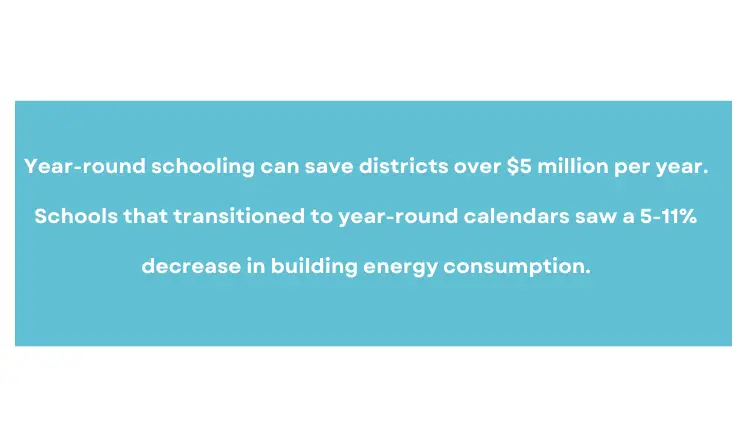
While year-round schooling allows for more efficient use of school facilities, it can also increase operational costs. Schools might face higher expenses related to utilities, maintenance, and staff salaries due to the continuous use of the facilities, which can strain school budgets and, by extension, taxpayer resources.
4. Enhanced Teacher and Student Well-being vs. Challenges in Extracurricular Planning
Regular breaks throughout the year can lessen stress and burnout among both teachers and students. This can foster a healthier school environment, as regular intervals for rest and rejuvenation can enhance overall well-being. Teachers may return more refreshed and prepared, which can positively impact their teaching effectiveness and student engagement.
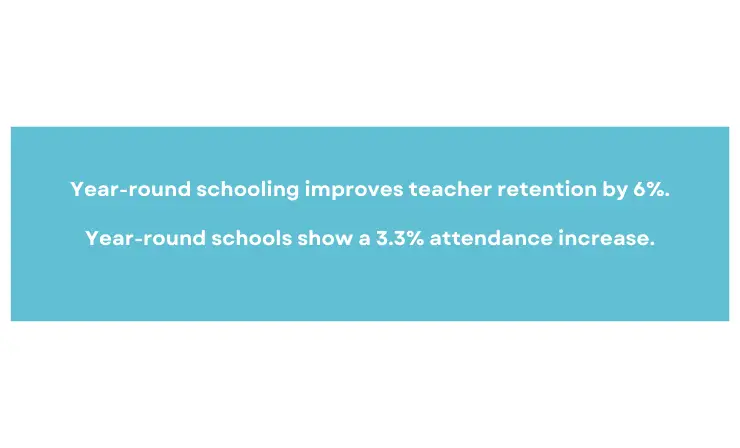
Regular breaks in year-round schooling can improve well-being, but they can also complicate extracurricular activities planning. Sports and other activities traditionally aligned with the longer summer break may struggle to find suitable schedules, potentially limiting students’ opportunities to engage in these important developmental experiences.
Dr. Matthew Lynch, an award-winning writer, activist, and editor of The Edvocate and The Tech Edvocate, discusses the year-round school system. He notes that while it can reduce summer learning loss and encourage innovative programs, it also disrupts family life, complicates childcare, affects extracurricular activities, increases administrative burdens, and requires effective use of extended school time to improve student performance. These challenges suggest that the drawbacks might outweigh the benefits.
What Teens Think About Year-Round School
Most American teenagers are used to the traditional school year running from August to May, with a lengthy summer break for rejuvenation. However, those in year-round schooling might have a different perspective. The decision between these two models is complex for school administrations.
In Dianna Mendez’s research on year-round education (YRE), a key observation was made during a summer visit to relatives in California. Contrary to the traditional school schedule, it was noted that her cousins were still attending school, which was an intriguing deviation from the norm. Mendez’s research further delved into the specifics of this year-round schedule.
To gather diverse perspectives, Mendez conducted interviews with approximately 38 students from traditional schools regarding the concept of year-round schooling. The responses varied, with some students open to the idea, citing benefits such as preventing long breaks that lead to learning loss and allowing more time for morning routines or evening homework. Others expressed concerns about the long summer break being more conducive to diminishing learning retention and the difficulty of re-adjusting to school routines after such breaks.
“I believe that schools across America should not be open year-round. With schools open year-round, more pressure can be put upon a student. Summer vacation gives students time to relax and a stress-free break. Studies show school does increase the chances of depression and anxiety in teens. The year-round school would increase these chances.
Year-round school could also hurt the economy. There would be no “back-to-school” sales, which means no extra income during this time of year. Many students also obtain summer jobs, teaching them responsibility. Summer vacation is necessary for our children to be happy and to become well-adjusted young adults.”
“I believe that kids should have the right to be kids. When you were a kid, didn’t you dream of summer? No school? Every kid longs for a long break when the work finally pays off. School in the summer helps kids—doing stuff they love or exploring new adventures, but it (YRE) also means that parents would be paying more money if their children go year-round.”
“I would rather finish one entire school year and have the entire three months than to be year-long in school and have breaks in between. I wouldn’t want to be in a year-long school because I wouldn’t want to feel like I’d be stuck in school forever. I think students would focus better knowing they only need to finish nine months of school, and then they can have a long break to look forward to.”
“I disagree. I think children need a break. I mean, if you put them in a year-round school, I wouldn’t be surprised if the suicide rate were much higher. I support the traditional school calendar because it has worked for centuries.”
“I think going to school all year around is a very bad idea. If schools do that, students would be so depressed. They wouldn’t even be motivated to finish the year because there is no end of the year. Their brains would be fried, and everyone would be dead. Having breaks allows for family vacations and are easier for parents to get off work.”
“Imagine you are lying out in the sun. The sound of waves in your ears and beautiful sand all around you. A beach umbrella over your head. Sound peaceful? Too bad you can’t fully enjoy it because in the back of your mind, you are stressing about an English paper due in the morning. No, with year-round school—you will never truly have that break from school and the relief it brings.”
Useful Resources
- Why Schools Are Important: The Benefits
- What are the major problems in schools?
- Summer Activities in School: A Guide to Fun and Learning Outdoors
Final Thoughts
In conclusion, while year-round schooling presents an innovative approach to education, it is evident that its complexities and challenges cannot be overlooked. The insights gathered from various aspects of this model, especially the perspectives of those directly affected – the students – highlight the need for a cautious approach. Before making any sweeping changes to our educational system, it is crucial to consider the full spectrum of implications, ensuring that the well-being and holistic development of students remain at the forefront of educational reform.
Explore “8 Reasons Why Students Should Have Mental Health Days: A Research-Based Analysis” for a deep understanding of mental health’s role in education. This article provides an in-depth, data-driven examination of the necessity of mental health days for students’ well-being and academic achievement, advocating for their integration into educational policies.
References
- Why Year Round School Is A Bad Idea
- What Teens Think About Year-Round School
- What Does Research Say About Staggered School Calendars?
- YEAR-ROUND SCHOOL: DIFFERENCE-MAKER OR WASTE OF TIME?
- Year-Round Schooling Grows in Popularity as States Incentivize Districts to Make the Switch
- Ask Dr. Lynch: What Are the Benefits and Drawbacks of Year Round Schools?
- Renowned child Psychologist Dr. Michael Thompson visits BIS
- YEAR-ROUND SCHOOLS: HOW IT AFFECTS TEACHERS
- Districts That School Year-Round
- AAA: Nearly 100 Million Americans Will Embark on Family Vacations this Year
